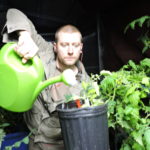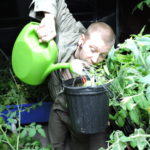Crew 188 Sol 9 Green Hab Report 06FEB2018
Zac Trolley (Engineer), Guest writing for Julia De Marines (Crew Astronomer/GreenHab Officer)
06 February 2018
Environmental control: Heating
Ambient with door opening: Shade cloth on
Working hours in Green Hab: 11:00 – 11:30, 18:00 – 19:00
Outside temp at working hour: 15ºC
Inside temp at working hour: 26ºC
Inside temp H: 33ºC
Inside temp L: 14ºC
Inside humidity: 23 %
Inside humidity H: 81%
Inside humidity L: 19%
Hours of supplemental light: 05:00 – 9:59
Changes to the crops: We picked many beans, herbs, and green leaves to dine upon.
Daily water usage for crops: 48 litres
Time(s) of watering plants: 11:00 – 11:30 (16 litres), 18:00 – 19:00 (32 litres)
Changes to research plants: The VEGGIE OASYS is progressing.
Narrative: Tat, our intrepid health and safety officer bravely foraged among the forest of plants being nurtured by our crew to bring home a bounty of green beans. Sadly, Sarah Jane has been unable to bridge the plant-human communication barrier.
Future needs and questions: We are awaiting the arrival of the tomato cages so we can replant the tall plants that require support to grow to their full potential. Please advise when they will arrive.





You must be logged in to post a comment.